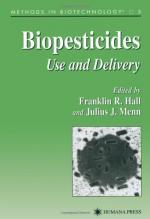|
This section contains 947 words (approx. 4 pages at 300 words per page) |

|
Plants, growing in the wild or in cultivation, face numerous threats from insects, bacteria, viruses, and fungi, as well as from other plants. Biopesticides are inert substances or living organisms that can help protect plants from such threats. Chemical pesticides can offer similar protection but, by contrast, are neither alive nor made by living organisms.
Natural Chemical Defenses
A variety of chemicals produced by plants help ensure that parasites, predators, plant feeders, and herbivores seldom increase in number sufficiently to destroy the plant populations they prey upon. Chemicals found in very low concentrations in certain plants have been found to help keep locusts from feeding on those plants, and some trees produce nearly 1,000 different chemical compounds that help them resist herbivores and parasites.
Living Organisms Serving as Biopesticides
Plant predators are themselves subject to attack by predators, parasites, and microbes, all of which can indirectly help protect a...
|
This section contains 947 words (approx. 4 pages at 300 words per page) |

|


